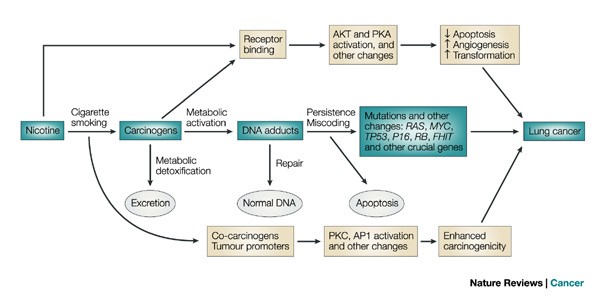What Are 4 Carcinogens
A carcinogen is any agent that directly increases the incidence of cancer. Most, but not all carcinogens are mutagens. Carcinogens that do not directly damage DNA include substances that accelerate cell division, thereby leaving less opportunity for cell to repair induced mutations, or errors in replication. Carcinogens that act as mutagens may be biological, physical, or chemical in nature, although the term is most often used in relation to chemical substances.


4 New Substances Identified as Carcinogens. Heath and Human Services has added four new substances, including a cleaning solvent and a wood preservative mixture, to its list of cancer-causing.
Group 1 Carcinogens List
Human Papilloma Virus (HPV, Figure (PageIndex{4})) is an example of a biological carcinogen. Almost all cervical cancers begin with infection by HPV, which contains genes that disrupt the normal pattern of cell division within the host cell. Any gene that leads to an uncontrolled increase in cell division is called an oncogene. The HPV E6 and E7 genes are considered oncogenes because they inhibit the host cell’s natural tumor suppressing proteins (include p53, described below). The product of the E5 gene mimics the host’s own signals for cell division, and these and other viral gene products may contribute to dysplasia, which is detected during a Pap smear (Figure (PageIndex{5})). Detection of abnormal cell morphology in a Pap smear is not necessarily evidence of cancer. It must be emphasized again that cells have many regulatory mechanisms to limit division and growth, and for cancer to occur, each of these mechanisms must be disrupted. This is one reason why only a minority of individuals with HPV infections ultimately develop cancer. Although most HPV-related cancers are cervical, HPV infection can also lead to cancer in other tissues, in both women and men.
Figure (PageIndex{4}): Electron micrograph of HPV.(Wikipedia-Unknown-PD)
- Carcinogens are most influenced by epithelial. They originate in epithelium because they begin on the surface. Observations suggest that carcinogens most commonly don't penetrate tissue very deeply.
- Chemical carcinogens can be classified into one of four groups according to their chemical nature: organic carcinogens, inorganic carcinogens, fibers, and hormones.
- In the last government report on carcinogens - known as the '11th Report on Carcinogens (RoC)' - 246 substances made it on the list. Of those substances, 58, such as alcoholic beverages, benzene, mustard gas and coal tars, were identified as known human carcinogens, while the other 188 were not as strongly labeled.
- Protecting yourself from these known carcinogens is the best way to reduce your cancer risk. But it doesn’t hurt to be careful when it comes to other potential dangers, Bevers says. Cell phones do emit a form of radiation. But Bevers says the type your.
Figure (PageIndex{5}): Dysplastic (left) and normal (right) cells from a Pap smear.(Flickr-Ed Uthman-CC:AS)
Radiation is a well-known physical carcinogen, because of its potential to induce DNA damage within the body. The most damaging type of radiation is ionizing, meaning waves or particles with sufficient energy to strip electrons from the molecules they encounter, including DNA or molecules that can subsequently react with DNA. Ionizing radiation, which includes x-rays, gamma rays, and some wavelengths of ultraviolet rays, is distinct from the non-ionizing radiation of microwave ovens, cell phones, and radios. As with other carcinogens, mutation of multiple, independent genes that normally regulate cell division is required before cancer develops.
What Are 4 Carcinogens Found In Tobacco
Chemical carcinogens (Table (PageIndex{2})) can be either natural or synthetic compounds that, based on animal feeding trials or epidemiological (i.e. human population) studies, increase the incidence of cancer. The definition of a chemical as a carcinogen is problematic for several reasons. Some chemicals become carcinogenic only after they are metabolized into another compound in the body; not all species or individuals may metabolize chemicals in the same way. Also, the carcinogenic properties of a compound are usually dependent on its dose. It can be difficult to define a relevant dose for both lab animals and humans. Nevertheless, when a correlation between cancer incidence and chemical exposure is observed, it is usually possible to find ways to reduce exposure to that chemical.
Table (PageIndex{2}): Some classes of chemical carcinogens (Pecorino 2008) |
1. PAHs (polycyclic aromatic hydrocarbons) e.g. benzo[a]pyrene and several other components of the smoke of cigarettes, wood, and fossil fuels 2. Aromatic amines e.g. formed in food when meat (including fish, poultry) are cooked at high temperature 3. Nitrosamines and nitrosamides e.g. found in tobacco and in some smoked meat and fish 4. Azo dyes e.g. various dyes and pigments used in textiles, leather, paints. 5. Carbamates e.g. ethyl carbamate (urethane) found in some distilled beverages and fermented foods 6. Halogenated compounds e.g. pentachlorophenol used in some wood preservatives and pesticides. 7. Inorganic compounds e.g. asbestos; may induce chronic inflammation and reactive oxygen species 8. Miscellaneous compounds e.g. alkylating agents, phenolics |
What Are Carcinogens Definition
Contributors and Attributions
Most Common Carcinogens
Dr. Todd Nickle and Isabelle Barrette-Ng (Mount Royal University) The content on this page is licensed under CC SA 3.0 licensing guidelines.